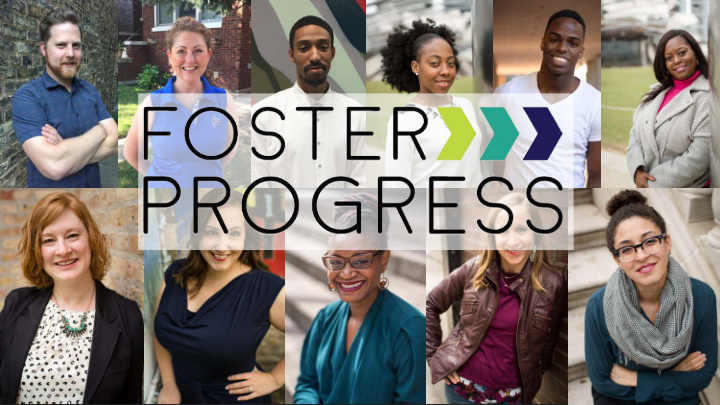



College Road Trips
College Mentoring & Scholarships
Workshops & Advocacy
Illinois DCFS Overview Who is the Department of Children and Family Services (DCFS)? Mission Statement ● Protect children who are reported to be abused or neglected and to increase their families' capacity to safely care for them ● Provide for the well-being of children in our care ● Provide appropriate, permanent families as quickly as possible for those children who cannot safely return home ● Support early intervention and child abuse prevention activities ● Work in partnerships with communities to fulfill this mission
There are approximately 17,000 children in foster care in Illinois. 32.3% of them, or 5,491 youth, are teens and young adults.
The Foster Experience Hotline Call Removal Court Investigation Placement Permanency
The Foster Experience l l H a o C t l i n e e n C i a l l t l o H Hotline Call Removal Court Emancipation Hotline Call Investigation Permanency Placement NOTICE
Aging Out 28,000 youth “age-out” of foster care each year in the US between the ages of 18-21. In 2011, Illinois had the third highest rate in the country of youth aging out. In 2011, around 50% of youth in Illinois exited foster care via emancipation.
Outcomes for youth aging out Midwest Evaluation of the Adult Functioning of Former Foster Care Youth at age 26, 2011 31% 50% 57% experience had been had been homelessness unemployed incarcerated
Outcomes for youth aging out
Degree Attainment 86% 3%
Degree Attainment
Hurdles Our Students Face lack of burdensome caring housing educational documen- biases adults and insecurity deficits tation family ties mental/ early financial medical emotional trauma parenthood instability issues health
Barrier: Finances Solution: Financial Aid ● ● Inadequate Financial Aid Generous Financial Aid packages, ● Insufficient or incorrect information not including loans ● about accessing financial aid Easy access to emergency funds ● ● No financial safety net Correct, thorough, easily digestible ● No supportive adult information at students’ fingertips ● ● Small fees are insurmountable Tuition and Fee Waivers ● hurdles Room and Board Waivers ● Student loans may be inadvisable ● “Youth in College” stipend is insufficient
DCFS Tuition and Fee Waiver ● Signed into law and in effect as of January 1, 2019 ● 219 students have utilized so far ● Public colleges in IL required to waive tuition and mandatory fees after other financial aid is applied for any youth who have experienced foster care, even if they were adopted, up to age 26 ● Due to Pell, MAP , and other aid, the amount being waived is minimal ● Most public hear “free tuition” and think “College is free!” ● Confusion about how to access this waiver ○ DCFS Form
Barrier: Solution: Lack of Support Foster Connections ● No/limited permanent family ● Meet and Greet: opportunity to support self-disclose status to others ● No financial or practical support ● Identify a DCFS Liaison on campus ● No one to turn to for emotional ● Establish a coaching model support or advice ● No ride to campus on move in day ● Protected, confidential status
Barrier: Solution: Housing Insecurity Housing Stability Before moving into college dorms, youth ● Keep dorms open during breaks are living in one of three places: ● Create a “home for the holidays” program like you may have for ● With foster parents international students ● ILO - Independent Living Options ● TLP - Transitional Living Program When they move to on-campus housing, they join a program called “Youth In College” which is a different “placement.”
Barrier: Burdensome Solution: Minimize Documentation Requirements ● When possible, have staff verify students’ ● Birth certificate status in foster care. ● State ID ● Only require what is federally mandated ● Proof of Wardship/Status as Foster Youth ● Train staff to use plain language, not ● Required questions about parent/guardian technical terms, and to give clear ● Independent Status on the FAFSA instructions on where to find documents ● Tax Transcript/Verification of Non-Filing ● Require verification only one time Youth often don’t have access to these documents or understand what they are and how to find them.
Psychological Emotional Promising Practices: On-Campus Support Programs Academic Key Program Components Success Counseling Housing Social Academic Support Coaching/Mentoring Connecting with other FCA Relationships with Key on-Campus Units Practical
Scholarships Tutoring Host Families Summer Bridge Peer Mentoring Program Strategic Academic Connection to Advising DCFS Resources Internships and Proactive health and Career Exploration wellness care Campus-wide Professional Development
Further Reading Campus Coaches Make Crucial Difference to Foster Youth in College, Youth Today College Campus Support Programs Are Strong Model of Services Helping Foster Youth , Youth Today Getting by and getting ahead: Social capital and transition to college among homeless and foster youth, Children and Youth Services Review Increasing Competency, Self-Confidence, and Connectedness Among Foster Care Alumni Entering a 4-Year University: Findings from an Early-Start Program, Journal of Social Service Research Experiences and outcomes of foster care alumni in postsecondary education: A review of the literature, Children and Youth Services Review Developing an on-campus recruitment and retention program for foster care alumni, Children and Youth Services Review
Thank you! www.foster-progress.org Kate Danielson 773-793-0951 kate@foster-progress.org
Recommend
More recommend